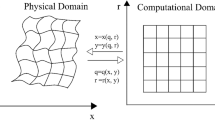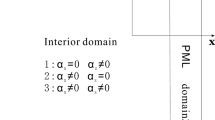Abstract
To absorb unwanted seismic reflections caused by the truncated boundaries, various absorbing boundary conditions have been developed for seismic numerical modeling in both time and frequency domains. Among the various types of perfectly matched layer (PML) boundary conditions, complex frequency shifted PML (CFS-PML) has attracted much attention in time-domain wavefield simulations because it can better handle evanescent and grazing waves. In this paper, we extend the CFS-PML boundary condition to frequency-domain finite-difference seismic modeling, which has several advantages over time-domain modeling including the convenient implementation of multiple sources and a straightforward extension of adding attenuation factors. A comparison with an analytical solution is used to investigate the validity of the proposed CFS-PML algorithm. CFS-PML shows better absorbing behavior than the classical PML boundary condition in our model tests. We further implement CFS-PML for seismic wavefield simulations in an elongated elastic model and a complex model (Marmousi-II) with a free surface boundary condition.














Similar content being viewed by others
References
Aki, K., & Richards, P. G. (2002). Quantitative seismology. Mill Valley: University Science Books.
Bécache, E., Petropoulos, P. G., & Gedney, S. D. (2004). On the long-time behavior of unsplit perfectly matched layers. IEEE Transactions on Antennas and Propagation, 52, 1335–1342.
Berenger, J. P. (1994). A perfectly matched layer for the absorption of electromagnetic waves. Journal of Computational Physics, 114, 185–200.
Cerjan, C., Kosloff, D., Kosloff, R., & Reshef, M. (1985). A nonreflecting boundary condition for discrete acoustic and elastic wave equations. Geophysics, 50, 705–708.
Chen, H., Zhou, H., & Li, Y. (2014). Application of unsplit convolutional perfectly matched layer for scalar arbitrarily wide-angle wave equation. Geophysics, 79, 313–321.
Clayton, R., & Engquist, B. (1977). Absorbing boundary conditions for acoustic and elastic wave equations. Bulletin of the Seismological Society of America, 67, 1529–1540.
Collino, F., & Tsogka, C. (2001). Application of the perfectly matched absorbing layer model to the linear elastodynamic problem in anisotropic heterogeneous media. Geophysics, 66, 294–307.
Doyon, B. and Giroux, B., 2014. Practical aspects of 2.5D frequency-domain finite-difference modelling of viscoelastic waves: The SEG Technical Program Expanded Abstracts, 3482-3486.
Festa, G., Delavaud, E. and Vilotte, J.P., 2005. Interaction between surface waves and absorbing boundaries for wave propagation in geological basins: 2D numerical simulations: Geophysical Research Letters, 32.
Gao, Y., Song, H., Zhang, J., & Yao, Z. (2015). Comparison of artificial absorbing boundaries for acoustic wave equation modelling. Exploration Geophysics, 48, 76–93.
Gvozdic, B. D., & Djurdjevic, D. Z. (2017). Performance advantages of CPML over UPML absorbing boundary conditions in FDTD algorithm. Journal of Electrical Engineering, 68, 47–53.
Higdon, R. L. (1986). Absorbing boundary conditions for difference approximations to the multidimensional wave equation. Mathematics of Computation, 47, 437–459.
Higdon, R. L. (1987). Numerical absorbing boundary conditions for the wave equation. Mathematics of Computation, 49, 65–90.
Hustedt, B., Operto, S., & Virieux, J. (2004). Mixed-grid and staggered-grid finite-difference methods for frequency-domain acoustic wave modelling. Geophysical Journal International, 157, 1269–1296.
Jo, C. H., Shin, C., & Suh, J. H. (1996). An optimal 9-point, finite-difference, frequency-space, 2-D scalar wave extrapolator. Geophysics, 61, 529–537.
Komatitsch, D., & Martin, R. (2007). An unsplit convolutional perfectly matched layer improved at grazing incidence for the seismic wave equation. Geophysics, 72, 155–167.
Lan, H., & Zhang, Z. (2011). Comparative study of the free-surface boundary condition in two-dimensional finite-difference elastic wave field simulation. Journal of Geophysics and Engineering, 8, 275–286.
Li, Y., Métivier, L., Brossier, R., Han, B., & Virieux, J. (2015). 2D and 3D frequency-domain elastic wave modeling in complex media with a parallel iterative solver. Geophysics, 80, 101–118.
Liao, J., Wang, H., & Ma, Z. (2009). 2-D elastic wave modeling with frequency-space 25-point finite-difference operators. Applied Geophysics, 6, 259–266.
Liu, W., Lin, P., Lü, Q., Chen, R., Cai, H., & Li, J. (2017). Time domain and frequency domain induced polarization modeling for three-dimensional anisotropic medium. Journal of Environmental and Engineering Geophysics, 22, 435–439.
Liu, Y., & Sen, M. K. (2012). A hybrid absorbing boundary condition for elastic staggered-grid modelling. Geophysical Prospecting, 60, 1114–1132.
Marfurt, K. J. (1984). Accuracy of finite-difference and finite-element modeling of the scalar and elastic wave equations. Geophysics, 49, 533–549.
Marfurt, K. J., & Shin, C. S. (1989). The future of iterative modeling in geophysical exploration. Handbook of geophysical exploration: Seismic Exploration. Oxford: Elsevier.
Martin, R., Komatitsch, D., & Ezziani, A. (2008). An unsplit convolutional perfectly matched layer improved at grazing incidence for seismic wave propagation in poroelastic media. Geophysics, 73, 51–61.
Meza-Fajardo, K. C., & Papageorgiou, A. S. (2008). A nonconvolutional, split-field, perfectly matched layer for wave propagation in isotropic and anisotropic elastic media: stability analysis. Bulletin of the Seismological Society of America, 98, 1811–1836.
Moreira, R. M., Cetale Santos, M. A., Martins, J. L., Silva, D. L. F., Pessolani, R. B. V., Filho, D. M. S., et al. (2014). Frequency-domain acoustic-wave modeling with hybrid absorbing boundary conditions. Geophysics, 79, 39–44.
Operto, S., Virieux, J., Amestoy, P., L’Excellent, J. Y., Giraud, L., & Ali, H. B. H. (2007). 3D finite-difference frequency-domain modeling of visco-acoustic wave propagation using a massively parallel direct solver: A feasibility study. Geophysics, 72, 195–211.
Operto, S., Virieux, J., Ribodetti, A., & Anderson, J. E. (2009). Finite-difference frequency-domain modeling of viscoacoustic wave propagation in 2D tilted transversely isotropic (TTI) media. Geophysics, 74, 75–95.
Peng, C., & Toksöz, M. N. (1995). An optimal absorbing boundary condition for elastic wave modeling. Geophysics, 60, 296–301.
Pratt, R. G. (1990). Frequency-domain elastic wave modeling by finite differences: A tool for crosshole seismic imaging. Geophysics, 55, 626–632.
Pratt, R. G., & Worthington, M. H. (1990). Inverse theory applied to multi-source cross-hole tomography. Part 1: Acoustic wave-equation method. Geophysical Prospecting, 38, 287–310.
Ren, Z., & Liu, Y. (2013). A hybrid absorbing boundary condition for frequency-domain finite-difference modelling. Journal of Geophysics and Engineering. https://doi.org/10.1088/1742-2132/10/5/054003.
Roden, J. A., & Gedney, S. D. (2000). Convolutional PML (CPML): An efficient FDTD implementation of the CFS-PML for arbitrary media. Microwave and optical technology letters, 27, 334–338.
Shin, C. (1995). Sponge boundary condition for frequency-domain modeling. Geophysics, 60, 1870–1874.
Taflove, A. (1998). Advances in computational electrodynamics: the finite-difference time-domain method. Boston: Artech House.
Tsynkov, S. V. (1998). Numerical solution of problems on unbounded domains. A review. Applied Numerical Mathematics, 27, 465–532.
Wang, Y. (2015). Frequencies of the Ricker wavelet. Geophysics, 80, 31–37.
Yin, W., Yin, X. Y., Wu, G. C., & Liang, K. (2006). The method of finite difference of high precision elastic wave equations in the frequency domain and wave-field simulation. Chinese Journal of Geophysics, 49, 561–568.
Yuan, S., Wang, S., Sun, W., Miao, L., & Li, Z. (2014). Perfectly matched layer on curvilinear grid for the second-order seismic acoustic wave equation. Exploration Geophysics, 45, 94–104.
Zeng, Y., He, J., & Liu, Q. (2001). The application of the perfectly matched layer in numerical modeling of wave propagation in poroelastic media. Geophysics, 66, 1258–1266.
Zeng, C., Xia, J., Miller, R., & Tsoflias, G. (2011). Application of the multiaxial perfectly matched layer (M-PML) to near-surface seismic modeling with Rayleigh waves. Geophysics, 76, T43–T52.
Zhao, J., Huang, X., Liu, W., Zhao, W., Song, J., Xiong, B., et al. (2017). 2.5-D frequency-domain viscoelastic wave modelling using finite-element method. Geophysical Journal International, 211, 164–187.
Acknowledgements
The authors acknowledge the Faculty Internationalization Grant at The University of Tulsa. The inverse Fourier transform was implemented by the CREWES Matlab Toolbox. The authors thank two anonymous reviewers and associate editor Dr. Andrew Gorman for their constructive suggestions and comments, which significantly improved the quality of our manuscript.
Author information
Authors and Affiliations
Corresponding author
Additional information
Publisher's Note
Springer Nature remains neutral with regard to jurisdictional claims in published maps and institutional affiliations.
Rights and permissions
About this article
Cite this article
Zhao, Z., Chen, J., Xu, M. et al. Complex Frequency Shifted Perfectly Matched Layer Boundary Conditions for Frequency-Domain Elastic Wavefield Simulations. Pure Appl. Geophys. 176, 2529–2542 (2019). https://doi.org/10.1007/s00024-019-02132-4
Received:
Revised:
Accepted:
Published:
Issue Date:
DOI: https://doi.org/10.1007/s00024-019-02132-4




